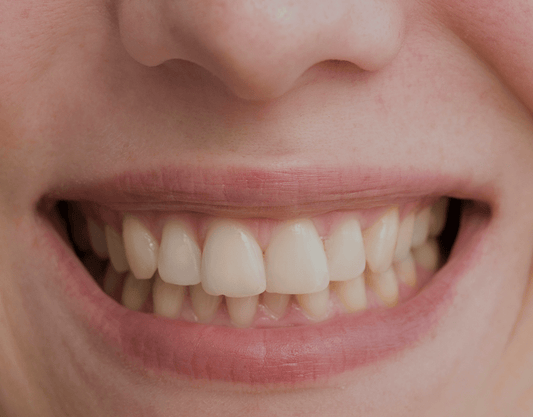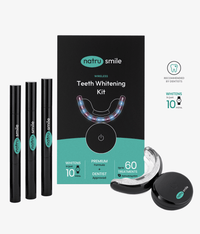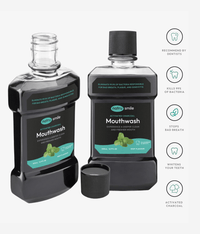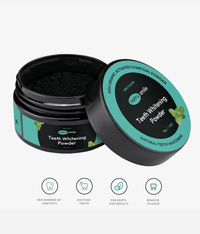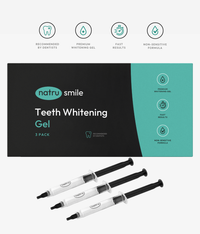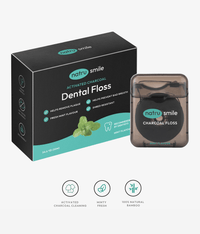
All products are certified by dental expert Dr. Greg Grillo
There are so many benefits of white teeth, whether you choose to whiten teeth naturally or opt for a professional whitening treatment. But sometimes, even after spending time and money on teeth whitening treatments, you may not see the desired results. This can be incredibly frustrating, and you may be wondering why your teeth whitening treatments aren’t working.
But you're not alone – many people have experienced similar struggles with teeth-whitening products.
The good news is that there could be several underlying reasons why your teeth whitening treatments are not working as expected, and understanding them can help you get better results in the future. There are also an array of teeth whitening options available, so you can choose the one that best suits your needs.
In this article, we'll discuss some of the common causes of ineffective teeth whitening treatments and permanent and temporary alternatives to consider.
11 Reasons Why Teeth Whitening Does Not Work For You
Here are some of the common reasons why your teeth whitening treatments may not be giving you the desired results:
Types Of Stains Or Spots
Certain types of tooth stains and discoloration are more challenging to remove than others. Intrinsic stains, which are caused by medications or aging, can be especially tough to remove. Teeth whitening treatments may not work if your teeth have this type of discoloration. Extrinsic stains, caused by foods and drinks, can usually be removed with teeth whitening treatments.
For example, deep yellow-brown or brown spots may not be removable with whitening treatments. If you have these kinds of stains on your teeth, you may need to consider other options such as dental veneers or crowns to improve their appearance.
If you want to get rid of white spots on teeth that are caused by fluorosis, you may need to use a special topical paste that contains fluoride. These white spots can be caused by having less enamel than is normal, diet, plaque accumulation, and too much exposure to fluoride during teeth development.
Product Type
The type of whitening product you use can also play a role in how effectively it works. Over-the-counter products may not be as effective as professional treatments, so if you are using an at-home teeth whitening solution and aren’t seeing results, consider getting a professional treatment with your dentist instead.
Before considering in-office whitening, it is always best to consult your dentist and get their opinion on which product will work best for your particular situation.
Or, you can experiment with different products to see which one works best for you - teeth whitening kits, strips, gels, and pens are all available.
Bleaching Gel Strength
The strength of the bleaching gel used in whitening treatments can also affect the effectiveness. If you are using a product with a low concentration of peroxide, it may not be strong enough to remove deep stains or discoloration.
To check how strong the gel is, look for the percentage of active ingredients on the product packaging. Typical active ingredients in whitening products include hydrogen peroxide, carbamide peroxide, and sodium tripolyphosphate.
These ingredients react with the stains on your teeth, called chromogens, and cause them to become a lighter color.
The percentage of active ingredients in an at-home whitening product is usually between 3% and 20%, while in-office whitening solutions contain 15% to 43%.
While products with stronger solutions will make your teeth whiter, you should take into account that higher concentrations may cause more teeth whitening side effects, such as sensitivity. Be careful not to leave the product on for too long in these cases.
Unclean Teeth
We can look at unclean teeth with an analogy: it would be difficult to paint a wall if there was already thick dirt on the surface. The same goes for teeth - if there is plaque and tartar buildup on your teeth, the whitening gel won't be able to penetrate properly and may not be as effective.
Before starting any whitening treatments, make sure you brush and floss your teeth regularly. You may also want to consider visiting a professional dental hygienist for a thorough cleaning before starting the whitening treatments.
Dental Restorations
If you have had a lot of dental restorations such as fillings, crowns, veneers, bonding, or bridges, the whitening gel may not be able to penetrate deep enough to reach these areas. If you have any of these treatments on your teeth, they will unlikely change color with a whitening product.
Broken Fillings & Cavities
If you have broken fillings or cavities, there are two potential problems that could be preventing your whitening treatments from working. Firstly, the filling will absorb some of the whitening gel and prevent it from reaching other areas.
Secondly, any decay in the teeth may not respond to whitening treatments at all.
It’s recommended to visit a dentist before attempting to use any type of teeth whitening treatment. The dentist can check for signs of decay and replace any old or broken fillings so that the whitening gel can be applied evenly and effectively.
Lack Of Connection With The Whitening Agent
If the whitening gel doesn't make contact with all of your teeth, it won’t be as effective. This can happen if you don’t use trays that fit properly or if you don’t apply the product evenly. Always make sure to follow the instructions carefully and leave the treatment on for the recommended amount of time. If you don't leave it on long enough, it won't be able to penetrate into your teeth fully and may not have the desired effect.
Gum Disease
If you have gum disease, the whitening gel may be ineffective because it won't be able to reach the discolored areas underneath your gums. In this case, we recommend that you consult a dentist and get treatment for your gum disease before attempting any kind of tooth whitening.
Enamel Density
Teeth with thicker enamel may be more resistant to whitening treatments. If you have naturally dense enamel, it may be harder for the product to penetrate and work properly.
Dead Or Decayed Teeth
Dead or decayed tooth enamel may not respond to whitening treatments. If this is the case, your dentist may need to rebuild the enamel before attempting any whitening treatments.
Genetics
Genetics may also play a role in how effective teeth whitening treatments are.
Some people have naturally brighter and whiter teeth than others, and no amount of whitening treatment can change that. Age-related stains may also be more difficult to remove, as the enamel of your teeth gets thinner with age.
Best Alternatives When Teeth Whitening Does Not Work
While teeth whitening treatments may not be effective for everyone, there are still a few alternatives that you can try if you’re not seeing the results you want.
Microabrasion
Microabrasion is a procedure that involves using tiny particles of aluminum oxide to remove stains from the surface of your teeth. It’s a fast and painless procedure, but it may need to be repeated several times for significant results.
Deeper, opaque stains may not be able to be removed with microabrasion, but the procedure can be combined with bleaching for better results.
Dental Bonding
Dental bonding is a procedure that involves applying a tooth-colored composite resin to your teeth, which can help hide stains and discoloration. The material is then hardened using a special light, forming it into the desired shape. Dental bonding isn’t permanent, but it can last for several years with proper care and maintenance.
Porcelain Veneers
Porcelain veneers are thin shells of ceramic material that are bonded to the front surface of your teeth. They can be custom-made to match the color and shape of your existing teeth, and they’re great for concealing permanent stains caused by fluorosis or tetracycline antibiotics. Porcelain veneers are a more expensive option than dental bonding or microabrasion, but they can last for up to 10 years or more with proper care.
Dental Crowns
Dental crowns are a permanent dental restoration procedure that covers the entire visible part of your tooth. They can be used to conceal discoloration caused by staining, as well as chips and cracks. Crowns are usually made from porcelain or ceramic materials, and they’re custom-made to match the shade of your existing teeth.
This option is especially helpful if you have one-off teeth that are severely stained or discolored, as it can restore the appearance of your smile.
Lumineers
Lumineers are a type of porcelain veneer that is thinner and more affordable than traditional porcelain veneers. Unlike other types of veneers, Lumineers don’t require any tooth preparation or drilling – they simply adhere to the surface of your existing teeth. This makes them a great option for anyone who wants to improve their smile without undergoing major dental work.
The Bottom Line
Teeth whitening treatments can be an effective way of restoring the natural beauty of your smile. However, not all treatments are suitable for everyone, and it's important to consider reasons why your teeth whitening treatments may not be working.
If you’ve tried over-the-counter products but still aren't getting the desired results, consider professional whitening procedures or alternative solutions such as veneers or crowns. We're confident that with the right approach, you'll be able to get your teeth looking as white and bright as ever!
Interested in learning more about teeth whitening? We’ve got you covered. Here are some frequently asked questions:
What Teeth Whitening Procedure Is The Best?
It depends on your individual needs and goals. Some procedures, such as microabrasion and dental bonding, may be more effective for certain types of stains than others. It’s best to speak with a dentist or cosmetic dentist to determine which procedure is right for you. Before choosing a procedure, ask yourself:
- What type of stains do I have?
- How much am I willing to spend?
- Do I want a permanent or temporary solution?
Ultimately, professional in-office whitening is the most effective option, as it can make your teeth three to eight shades lighter - providing the best results. The way treatments like Zoom whitening or laser whitening work is that they use a higher concentration of bleaching agents than over-the-counter products and are applied with special equipment to enhance the process.
Why Don't My Teeth Stay White After Whitening?
Many teeth whitening treatments, like gels and strips, aren’t permanent solutions – they only last for a certain amount of time before the stains reappear. This is why you’ll want to maintain good dental hygiene habits and avoid eating or drinking products that can stain your teeth in order to keep them looking white longer.
What Type Of Teeth Cannot Be Whitened?
Teeth that are severely discolored due to medications, fluoride, and trauma may not respond to whitening treatments. In these cases, a cosmetic dentist may recommend other options, such as veneers or crowns.
Why Won't My Yellow Teeth Whiten?
Yellow teeth are usually more difficult to whiten than other stained teeth. This is because yellow stains come from inside the tooth, rather than from the surface. Therefore, to get rid of yellow teeth, you may need a professional whitening treatment to achieve your desired results.
Why Are My Teeth Not Whitening When I brush It Everyday?
The whitening toothpaste you use may not be strong enough to remove deep-set stains. If this is the case, consider using a stronger whitening toothpaste or trying other treatments, such as laser whitening or veneers.
Whitening toothpaste differs from regular toothpaste in that it contains ingredients such as hydrogen peroxide, baking soda, and silica. These ingredients help to remove surface stains on your teeth. However, they are still not strong enough to remove deep-set stains caused by aging or certain medications.

